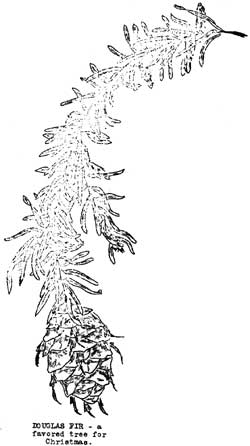
 | ||||||||

Even as this is written - but a few days after Thanksgiving - one may see trucks loaded with "Christmas Trees" on the highways outside the park, traveling to the various towns and cities. Market places will be fragrant with their scent and soon hundreds of homes will be brightened by their presence on Christmas Day. Yet, in spite of the important place the "Christmas Tree" occupies at this season one rarely favors them with more than casual interest. Their identity, their peculiarities and their many other features of interest are submerged in the festivities of the yuletide. But a study of your "Christmas Tree" will reveal many things of interest. Count the rings that can be seen in a cross section of its trunk and learn how old it is. Each ring. of course, indicates one year's growth. But your tree was already several years old when it attained a size sufficient to make its diameter increases apparant at the point where the woodsman's axe cut it down. It had its origin in a small seed held, until maturity, between the scales of a cone upon the branches of the parent tree. A highly specialized unit was this seed, containing an embryo - really the plant in miniature - together with food substances which nourished the young plant during the first stages of its development. In that state it rooted, probably for sometime, until conditions were suitable for its development. Then active growth and development began. Roots were formed. Likewise the first aereal shoot, later to develop into the trunk, pushed through the soil. Immediately it began active competition with other plants in the well known law of the survival of the fittest. Competition for the nourishment of the soil and competition for air and light above the ground but we may assume that your tree did not come out second best in most of this competitive business of living. The beginning of each year's growth in the spring prompted the formation of new tissues at the ends of the branches and the terminal shoot. In these the cells were essentially the same -- but not for long. Your tree, is a complex organism - a unified combination of tissues which serve for support, transportation of foods and water to various parts of the tree, for protection and many other things. So these first tissues gradually underwent changes which resulted in the formation of specialized organs. And so your tree grew in height in this manner. Likewise its branches became longer. But growth in height alone will not, of course suffice. It must enlarge in diameter and so, on the heels of height growth comes growth in diameter, brought about by the cambium layer - one of the specialized organs formed from that first unified tissue. With tine coming of new energy in the spring diameter growth was very apparant. The cells formed by the cambium - which also differentiated into special purpose organs - in the spring were necessarily large and generally thin walled. Later the opposite was true - growth diminished gradually and the cells were smaller and thicker walled; hence the difference in color between the spring and summer wood which accounts for the appearance of "rings" by which the age of your tree is determined. And so it continued, growing in height and diameter year by year, meeting and conquering the obstacles which presented themselves in competition with other plants. But at last there presented itself one obstacle which the tree was powerless to overcome. The woodsman's axe bit deep into its flesh; once, twice, three times. Three blows were all that was necessary to sever such a small tree. So now you have it, tinseled and ornamented in the living room of your home. (C.F.B.) | ||||||
| <<< Previous | > Cover < | Next >>> |
vol9-12b.htm
12-Jun-2001